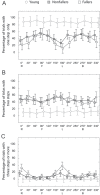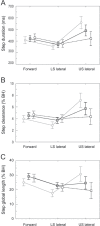One step, two steps, three steps more ... Directional vulnerability to falls in community-dwelling older people
- PMID: 23685768
- PMCID: PMC3814241
- DOI: 10.1093/gerona/glt062
One step, two steps, three steps more ... Directional vulnerability to falls in community-dwelling older people
Abstract
Background: Falls leading to disability are common occurrences with advancing age. Stepping is a natural protective option for maintaining balance and preventing falls. There are directionally dependent challenges for protective stepping associated with falls among older individuals. The aim of this study was to determine the stepping response patterns evoked by different directions of externally applied postural disturbances in younger and older adults and in relation to falls.
Methods: Seventy-five community-dwelling adults were tested: 26 younger adults and 49 older adults. Fall history of older participants was tracked prospectively for 1 year after testing. Steps were randomly evoked in 12 directions by a motorized waist-pull system. The number of recovery steps, type of stepping strategy, and first step kinematic characteristics were determined.
Results: Younger participants mainly used single recovery steps regardless of the perturbation direction. For the older groups, multiple steps occurred predominantly and were least for the forward-backward directions and greatest for the lateral directions. Trials with three or more recovery steps were increased laterally only for the fallers. Overall, fallers initiated stepping earliest, but other stepping characteristics were similar between the groups for forward-backward perturbations. Aging differences in stepping strategies for diagonal and lateral perturbations included numerous interlimb collisions. Adaptive changes in stepping characteristics between forward and lateral perturbations were also observed in relation to age and risk of falls.
Conclusions: These results indicated an age-associated reduction in balance recovery effectiveness through stepping particularly for the lateral direction among older individuals at greater risk for falls.
Keywords: Balance; Falls; Motor control..
Figures




Similar articles
-
Kinematic and behavioral analyses of protective stepping strategies and risk for falls among community living older adults.Clin Biomech (Bristol). 2016 Jul;36:74-82. doi: 10.1016/j.clinbiomech.2016.04.015. Epub 2016 Apr 29. Clin Biomech (Bristol). 2016. PMID: 27228075 Free PMC article.
-
Lateral stability during forward-induced stepping for dynamic balance recovery in young and older adults.J Gerontol A Biol Sci Med Sci. 2001 Sep;56(9):M589-94. doi: 10.1093/gerona/56.9.m589. J Gerontol A Biol Sci Med Sci. 2001. PMID: 11524454
-
Lateral Perturbation-Induced and Voluntary Stepping in Fallers and Nonfallers After Stroke.Phys Ther. 2020 Aug 31;100(9):1557-1567. doi: 10.1093/ptj/pzaa109. Phys Ther. 2020. PMID: 32529236 Free PMC article.
-
Lateral stability and falls in older people.Exerc Sport Sci Rev. 2003 Oct;31(4):182-7. doi: 10.1097/00003677-200310000-00005. Exerc Sport Sci Rev. 2003. PMID: 14571957 Review.
-
Comparison between investigations of induced stepping postural responses and voluntary steps to better detect community-dwelling elderly fallers.Neurophysiol Clin. 2015 Nov;45(4-5):269-84. doi: 10.1016/j.neucli.2015.07.003. Epub 2015 Sep 26. Neurophysiol Clin. 2015. PMID: 26412442 Review.
Cited by
-
The Stepping Threshold Test for Reactive Balance: Validation of Two Observer-Based Evaluation Strategies to Assess Stepping Behavior in Fall-Prone Older Adults.Front Sports Act Living. 2021 Oct 11;3:715392. doi: 10.3389/fspor.2021.715392. eCollection 2021. Front Sports Act Living. 2021. PMID: 34708198 Free PMC article.
-
Comparison of Lateral Perturbation-Induced Step Training and Hip Muscle Strengthening Exercise on Balance and Falls in Community-Dwelling Older Adults: A Blinded Randomized Controlled Trial.J Gerontol A Biol Sci Med Sci. 2021 Aug 13;76(9):e194-e202. doi: 10.1093/gerona/glab017. J Gerontol A Biol Sci Med Sci. 2021. PMID: 33491052 Free PMC article. Clinical Trial.
-
Single and multiple step balance recovery responses can be different at first step lift-off following lateral waist-pull perturbations in older adults.J Biomech. 2017 Apr 11;55:41-47. doi: 10.1016/j.jbiomech.2017.02.014. Epub 2017 Feb 21. J Biomech. 2017. PMID: 28285746 Free PMC article.
-
Curvilinear walking elevates fall risk and modulates slip and compensatory step attributes after unconstrained human slips.J Exp Biol. 2024 Mar 15;227(6):jeb246700. doi: 10.1242/jeb.246700. Epub 2024 Mar 27. J Exp Biol. 2024. PMID: 38456285 Free PMC article.
-
Kinematic and behavioral analyses of protective stepping strategies and risk for falls among community living older adults.Clin Biomech (Bristol). 2016 Jul;36:74-82. doi: 10.1016/j.clinbiomech.2016.04.015. Epub 2016 Apr 29. Clin Biomech (Bristol). 2016. PMID: 27228075 Free PMC article.
References
-
- Hornbrook MC, Stevens VJ, Wingfield DJ, et al. Preventing falls among community-dwelling older persons: results from a randomized trial. Gerontologist. 1994;34:16–23 - PubMed
-
- Hausdorff JM, Rios DA, Edelberg HK. Gait variability and fall risk in community-living older adults: a 1-year prospective study. Arch Phys Med Rehabil. 2001;82:1050–1056 - PubMed
-
- Maki BE, McIlroy WE. Control of rapid limb movements for balance recovery: age-related changes and implications for fall prevention. Age Ageing. 2006;35(suppl 2):ii12–ii18 - PubMed
-
- Pai YC, Rogers MW, Patton J, Cain TD, Hanke TA. Static versus dynamic predictions of protective stepping following waist-pull perturbations in young and older adults. J Biomech. 1998;31:1111–1118 - PubMed
-
- Mille ML, Rogers MW, Martinez K, et al. Thresholds for inducing protective stepping responses to external perturbations of human standing. J Neurophysiol. 2003;90:666–674 - PubMed
Publication types
MeSH terms
Grants and funding
LinkOut - more resources
Full Text Sources
Other Literature Sources
Medical

